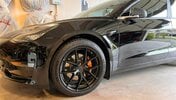brkaus
Well-Known Member
Well, my other option would be to drive all the time with the windows closed and the climate control off. I’m all for science, but that would have been a very uncomfortable 4.5 years with the car!Obviously if you're including information about heat AC or preconditioning of the battery in your kilowatt hours per mile that is misleading and in a real sense uninterpretable. Because you don't know how much is the drivetrain and how much is the other stuff.
These numbers extracted from the car api by teslafi match what it says on the dash. Which I’m pretty is what others here are reporting as well.




